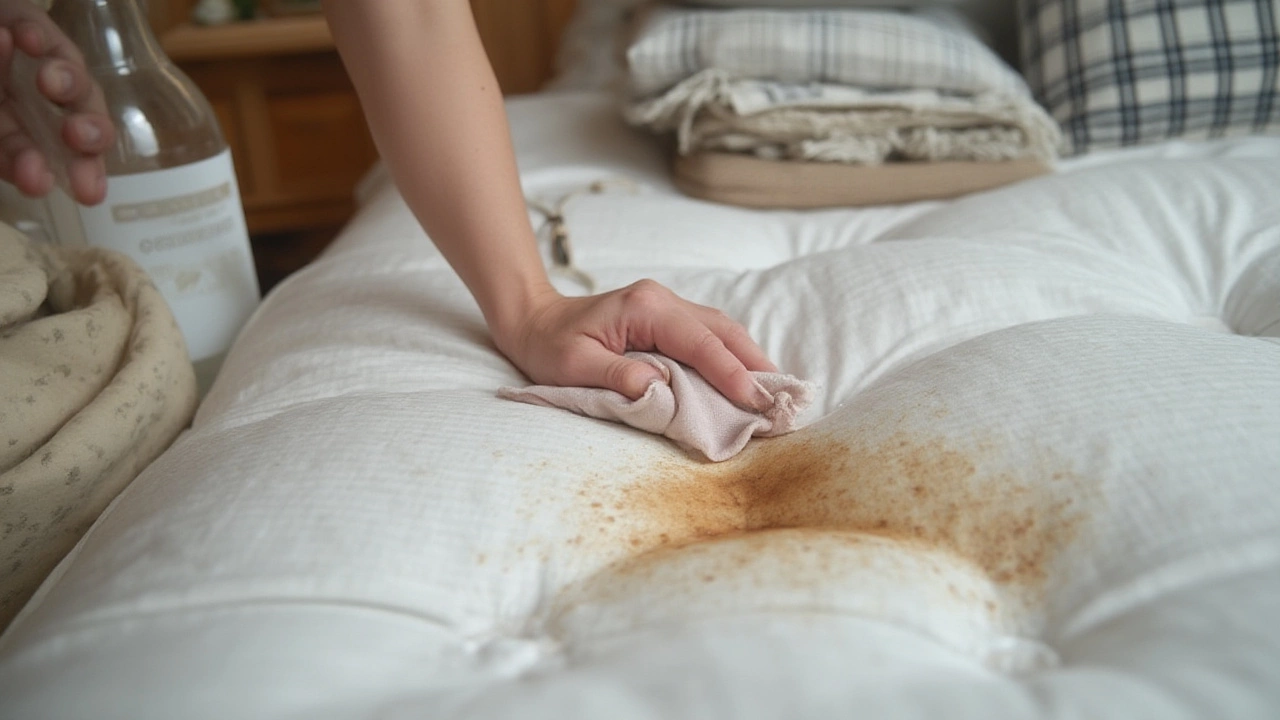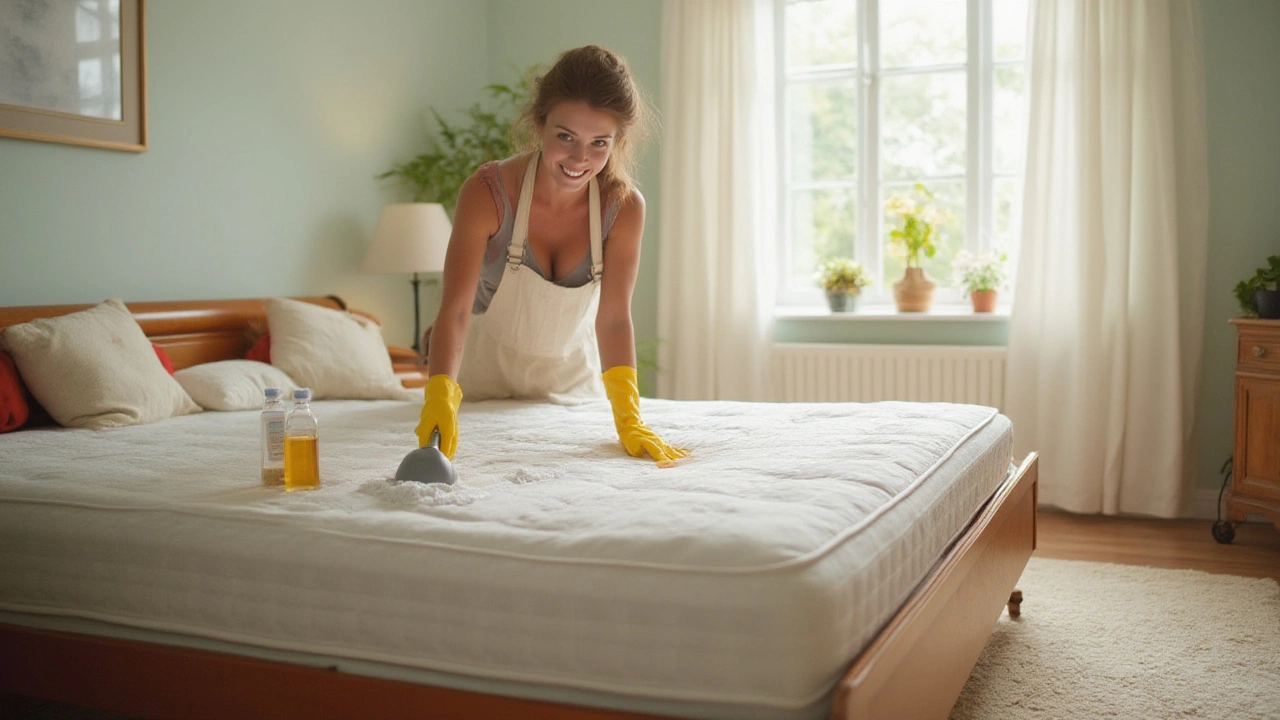Mold, mystery stains, and suspicious smells—mattresses end up hiding a lot more than just dreams. You might be surprised by what’s lurking right under your sheets. A mattress can be a breeding ground for things like dust mites, skin flakes, sweat, and even the occasional nighttime spill. But don’t let that make you sweat; cleaning a mattress is much easier than most people think, and it rarely needs industrial strength cleaners or fancy equipment. In fact, once you know what you’re doing, the whole process becomes just another part of home care, like washing your clothes.
Why Regular Mattress Cleaning Matters
When was the last time you really thought about what’s living in your mattress? Unless you've caught a whiff of something odd or seen a stain, it probably hasn't crossed your mind. But here’s a fun (or maybe unsettling) fact: an average mattress can double its weight in ten years due to the accumulation of dust mites and their debris. That’s right, your comfy mattress could be heavier now than when you bought it—and not because of the latest memory foam tech upgrades.
Dust mites aren't dangerous on their own, but their droppings can trigger allergies, cause sneezing, and disturb your sleep. Sweat, dead skin, and oils from your body also get absorbed with every sleep, serving up a smorgasbord for those mites. And then there are the stains—spilled drinks, pet mishaps, or breakfast in bed gone wrong. Even if nothing dramatic happens, moisture from humidity or sweat can set up the perfect environment for mold and mildew. So, cleaning is more than just getting rid of an ugly stain; it’s about your comfort, health, and the mattress’s lifespan.
Experts recommend a deep clean every six months, plus spot cleaning when things happen. If you suffer from allergies or have young kids or pets, doing it more often keeps the bedroom fresher. Studies from the American Lung Association show that regular mattress cleaning cuts down dust mite populations by over 60%—which seriously helps with nighttime coughing or that runny nose you can’t explain. Plus, let's not forget that a clean mattress just feels better. Most people sleep more soundly when their bedroom smells fresh, and the risk of waking up with bug bites or rashes drops like a stone.
Don’t fall for the myth that only pros can handle mattress duty. Sure, heavy-duty infestations or certain warranties might need specialist help, but by sticking to a simple routine you handle yourself, you can avoid most problems and keep your investment in top shape for years. Think about how much life your mattress has seen—movie marathons, sick days, late-night snacks. It deserves some love, and yes, you can do it yourself.
Preparing to Clean Your Mattress: What You’ll Need
Before you start, getting your supplies together makes the job way less stressful. Most of the stuff you need is already in your cleaning cupboard or kitchen. No reason to shell out for fancy sprays or powders. Here’s what you’ll need for a solid DIY session:
- Vacuum cleaner with upholstery attachment (a handheld one is fine)
- Baking soda—absorbs odors and helps lift stains
- White vinegar—disinfects and helps with stubborn marks
- Mild dish soap or laundry detergent
- A bowl, clean sponge or soft cloths
- Spray bottle (for vinegar solution)
- Optional: essential oils, like lavender or tea tree, for a nice scent
Make sure you tackle the job on a day when you can open your windows or start a fan. Fresh air helps everything dry faster and stops musty smells from lingering. Also, strip off all the bedding and throw it in the wash before starting. You don’t want to clean your mattress only to cover it with sheets full of the same dust.
If your mattress has a removable cover, check the label—some can be machine washed, but most memory foam or hybrid beds can’t get too wet. Unless you want to risk ruining the foam or pocket springs, stick to lightly damp sponges and never soak the mattress.
Set aside a couple of hours for the whole process, but don’t worry, most of it is hands-off waiting. And if you feel like a little multi-tasking, now’s the perfect time to dust and wipe down bed frames or rotate your mattress for wear-evening. The more often you do it, the quicker each clean gets.

Step-by-Step: Deep Cleaning Your Mattress at Home
Here’s where the magic happens. Start with vacuuming. Give every inch a slow, thorough once-over with the upholstery tool—even the sides. Pay close attention to seams and crevices where crumbs, hair, and lint love to hide. If you own pets, you might have to go over it twice. The goal? Suck up as much debris as possible. You don’t need a huge vacuum; even small, handheld models work wonders for this.
Up next: deodorize. Sprinkle a light, even layer of baking soda over the mattress, rubbing it in gently with your hands. Leave it there for at least 30–60 minutes; an hour is best if you’ve got the time. Baking soda draws out odors and pulls moisture from the material. If you want a subtle scent, mix a few drops of lavender or eucalyptus oil into the baking soda before you sprinkle it around.
Got stains? That’s where the real challenge kicks in. Don’t reach for harsh bleaches—they break down the mattress stuffing and mess with memory foam. Instead, mix one part mild dish soap with two parts water. Dab the solution on the stained area, gently pat it in, and let it sit for five minutes. Afterward, blot with a clean, barely damp cloth. For tough stains—like blood, wine, or urine—dab a little hydrogen peroxide, but test on a small hidden area first. Never soak or pour liquid directly onto your mattress.
If musty smells linger or you want a quick disinfecting boost, lightly spritz a white vinegar and water mix (equal parts) over the mattress. Don’t worry—the vinegary smell fades as it dries. Always let everything air dry completely and avoid making the surface too wet, especially with memory foam. Any leftover moisture invites mold to set up shop.
Flip or rotate your mattress before putting the clean bedding back on. Even mattresses labeled "no-flip" can usually be rotated head-to-foot. This simple trick extends its life and makes sure you don’t end up with a permanent body groove in the middle. A sturdy mattress protector keeps future spills and stains at bay, and they’re much easier to wash than wrestling a giant mattress around your bedroom.
How Often Should You Clean Your Mattress? Tips for Keeping It Fresh
Look, mattresses don’t need babying every single week, but ignoring them for years is a mistake. Here’s a handy schedule: give your mattress a quick vacuum once a month, a thorough deep-clean every six months, and spot clean whenever spills or accidents strike. If someone in your home has allergies, try bumping up the frequency—studies show reducing dust exposure can improve breathing and sleep in just a few nights.
Regularly wash your sheets and covers—at least once a week keeps dead skin and sweat from soaking in. Sweat stains are the most common mattress complaint. According to one manufacturer survey from 2024, over half of adults said they’d spilled coffee or food in bed in the past year—life happens. Mattress protectors help, but even the best ones benefit from washing every few months.
Don’t forget your bed frame or box spring. Dust settles everywhere, and any hidden mold or mildew on the support can transfer back to your mattress. Quickly wiping those down pays off in longer bedding life. If you travel or have guests often, it’s smart to check for signs of bed bugs, which tend to hide in tiny seams. Finding black specks or tiny rust-colored spots? Call a professional for that—DIY sprays rarely work once they’ve established a nest.
Sunlight is an underrated natural cleaner. If you can, place your mattress next to a sunny window or, if manageable, outside for an hour or two. UV rays help kill bacteria and keep musty smells in check. It’s an old-school trick hotels still use today! Just make sure it doesn’t rain—and bring it in before evening dew.
Want to keep your bed feeling and smelling amazing? Pop a sachet of dried lavender or cedar in your linen closet, or add a few drops of essential oil to your sheets before making the bed. Not only does this keep things extra fresh, but you’ll fall asleep with that just-washed linen scent every night.
So, yes, you really can clean a mattress yourself. With a few common supplies, a bit of effort, and a dash of patience, your mattress can be as fresh as the day it was delivered—maybe even cleaner. The extra bonus? A clean bed means better sleep, and better sleep makes everything else easier. Your mattress is the unsung hero of your home, so don’t let it down. Give it a little DIY attention once in a while, and you’ll both rest easier.
